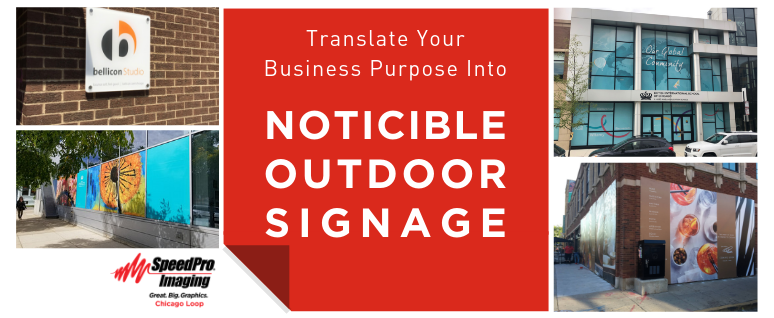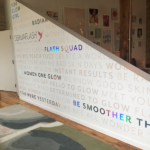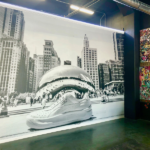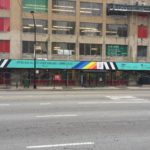
HOW CAN I MAKE MY OUTDOOR SIGNAGE MORE NOTICEABLE?
MAY 17, 2019| SpeedPro Chicago LoopCategories
PrintingThree out of four shoppers will visit a new store for the first time based on its signage, while many shoppers say a store’s signage is a direct reflection on its product and service quality. Numerous studies from both industry institutions to public research universities drive this point home — your organization’s outdoor signs have the power to increase — and then retain — store traffic, leading to higher sales.
You’re not alone if statistics like this inspire a revitalization in your business’ signs. Use the following outdoor signage design tips to create your company’s best, most attractive signs to date.
1. USE COMPLEMENTARY COLOR SCHEMES
You don’t have to get a Ph.D. in color theory to harness the power of color psychology.
Signs can use one of three established color-theory methodologies to boost professionalism, legibility and their overall, on-brand appearance:
Biadic or triadic color schemes: Biadic or triadic color schemes pair colors based on their position on the color wheel. As the roots of their names suggest, biadic schemes use two opposing colors, such as yellow and purple, whereas triadic colors use three colors equally spaced on the color wheel, such as light orange, purple and green. The results are high-intensity imagery with natural light and dark components.
Gradient schemes: Also called monochrome schemes, gradient schemes select one dominant color, then accent it with various shades of that same color. Signs with gradient schemes may lack the high-contrast intensity of biadic or triadic color schemes, but they can appear more polished and luxe.
Split complementary schemes: Split complementary schemes pair one dominant color with two other colors that sit to either side of the dominant color’s direct opposite. For example, if the dominant color is red, the split-complement colors are light green and teal since those are the colors on either side of red’s direct opposite, green. Split complementary schemes lend signs a brighter and more complex color palette while maintaining high levels of contrast but can take extra work to balance attractively.
2. PRIORITIZE READABILITY
Legible signs follow what’s known as “writing in headline text,” a process that strips away any unnecessary content. Signs written using a headline text strategy are direct, clear and concise, relaying core information like a company’s name, a USP-related sentence and — at the most — a call to action.
Readability also means sign font and lettering size. A good industry rule of thumb is the 10-by-1 rule, which states one inch of letter height can generally be read at a maximum of ten feet away.
Writing readable signs may seem obvious. Yet so often the “obvious” elements of design are the ones that get most overlooked.
3. DON’T FORGET SIGN DEPTH OR TEXTURE
Texture provides contrast for outdoor signage, which increases both its readability and general appearance. Signs that include these visual elements also have an easier time distinguishing themselves from their surroundings, their detailing allowing them to pop on the street.
Shading: Shading increases letter readability. Signs can incorporate shading into the design itself through chosen fonts and prints or by placing lights around the sign to cast strategic shadows.
Tone and hue contrast: Contrasting colors give letters and graphics a natural pop. Signs with contrasting colors using the methodologies described earlier will naturally increase depth and textures.
Pop-out materials or textiles: Signs are often tied to the appearance of the 2D materials they’re fashioned from. While this most often includes base substrates like vinyl and canvas, it can also incorporate elements that look more 3D, such as contour-cut signage.
4. SEE WHAT’S ALREADY OUT THERE
Noticeable outdoor signage is unique outdoor signage. Your visual media can’t be entirely unique if it reminds passersby of someone else’s brand.
Evaluate the outdoor signage of other businesses in your industry. Look out for both the types of signs they use as well as their designs and placements. Drive around town if you have to, taking notes on what stands out. The goal is to survey your community’s landscape proactively to avoid the waste of branded materials that end up being brandless.
5. MAKE THEM LAUGH
Humor is a powerful means to capture audience attention — and elicit a positive response. Decades of research maintains that brands using humor effectively forge quicker and more lasting recall rates and social connections with their target audience, using trends of the moment to fuel smarter marketing outcomes.
Humor is subjective though, and highly demographic. Humorous advertising works best when it connects with a targeted audience and plays with conventions, either adding to or spinning off pop culture or other widely-known references. Your signs can playfully connect with passers-by in several ways:
Puns
Jokes
Parodies
Absurdist Depictions
6. GO DIGITAL
Digital signage shakes up the conventional, static signs spotted along the street. Since these signs use screens instead of printed substrates, they are innately bright, flashy and readily customizable. Businesses can easily swap and replace the text and images on its digital signs without having to install something new every time branding efforts change.
Digital signs are especially beneficial if your operation changes its products and services frequently. For example, an ice cream parlor could advertise its flavor of the day, a restaurant its weekly menu and a gas station its daily fuel prices and snack specials.
7. LIGHT IT UP
Adding a light source to your signs will turn your outdoor signage into a 24/7, weatherproof advertising canvas.
Backlit signage comes in a few varieties. The most common use LED lights and frames surrounded by a fabric overlay that serves as your sign’s front face. When switched on, your sign illuminates text and graphics from the inside out. The results are enhanced sign aesthetics, clarity and readability.
8. ADD GRAPHICS
Consumers often glean a company’s character or “personality” based on its outdoor signs, making outdoor graphics that much more important.
Researchers believe this success comes down to heuristic cues. Signs with graphics can relay additional, branded information about a business or service. Compared to text-only signs, graphics are languageless and have the potential to be instantly recognizable.
9. REACH FOR THE SKIES — WITHIN REASON
There’s a Goldilocks ideal when it comes to sign height — too short, and your sign’s visibility and reach will be dramatically reduced. Yet too tall, and you risk decreasing readability and legibility while increasing the complexity of sign installation.
In general, larger signs will capture more attention because they’ll be easier to read, whereas smaller signs won’t be as visible from a distance. However, ensure you’re not placing signs at the same height as others on your street. Otherwise, you risk getting lost in the landscape.
Your sign’s most appropriate height comes down to two variables — it’s marketing purpose and the timeline of that purpose. Short-term marketing or advertising initiatives have more height flexibility, whereas long-term branding efforts rely on height for impact. Typically, the longer you intend for a sign will be mounted, the higher you’ll want it installed.
10. LOCATION, LOCATION, LOCATION
Where’s your business most likely to “catch” its ideal customer? While they walk on the sidewalk? Drive down the road? Is that sidewalk or road directly adjacent to your storefront, meaning customers won’t have to sift through a strip mall or similarly store-busy environment to find you?
Opt to place your outdoor signs where they’ll functionally attract the most customers — and where those customers will have the easiest time navigating from sign to storefront. It does no one any good if you’re installing large-format branded materials on the nearby busy road — and theoretically capturing more attention — but that road doesn’t allow easy access to your business.
11. PLAY WITH EXPECTATIONS
Outdoor signage represents your business. It conveys a tone and a personality, as well as what customers can expect when they step foot inside your space.
However, your goal with outdoor signage is still to attract customers. A huge part of successfully doing so involves capturing attention in the first place, and building instantaneous brand recognition with Surface Impact™. What better way to do so than by tactfully surprising viewers?
Playing with visual expectations is a hallmark strategy of creative outdoor signage. Through shapes, colors, icons, messages, interactive features, placement and more, you can enhance the eye-catching components of traditional outdoor graphics. And you can do so while still maintaining brand consistency and professionalism, not exercising shock value.
12. LESS REALLY IS MORE
The International Sign Association itself states a successful outdoor sign holds four qualities:
Detectable
Conspicuous
Legible
Comprehensible
Compare your sign designs to each of these metrics. Be honest, asking yourself if a word, image or detail adds to or detracts from sign detectability, legibility, comprehension and detection. If it does, omit it. Consumers will thank you.
LEARN MORE HOW TO ATTRACT CUSTOMERS WITH NOTICEABLE, ON-BRAND OUTDOOR SIGNAGE
Have questions about the effectiveness of your outdoor signs? Looking to attract customers to your store but for all the right reasons? Our team of experts at SpeedPro Chicago Loop specialize in eye-catching, large-format prints with Surface Impact™ — prints that bring your brand to life.










